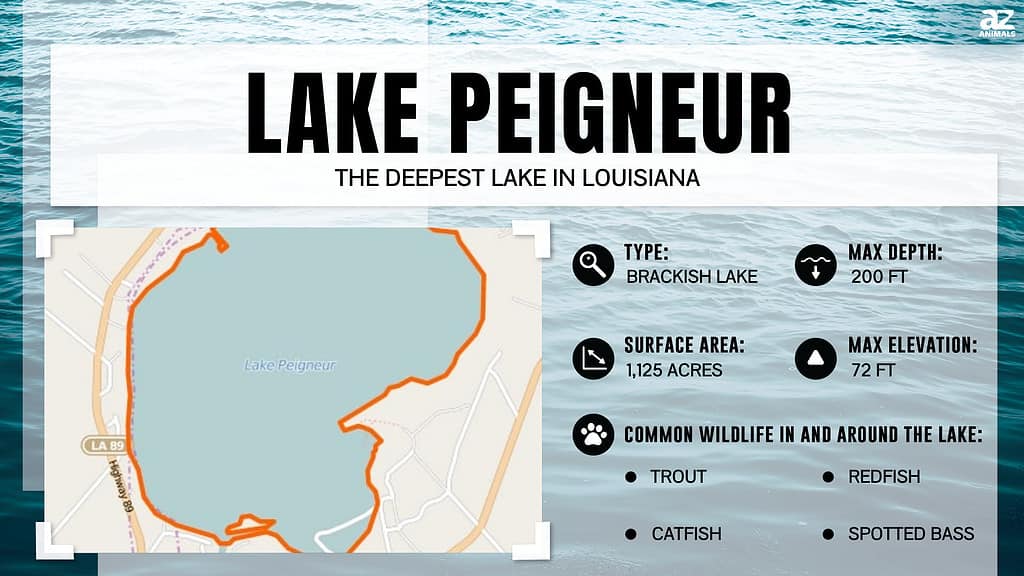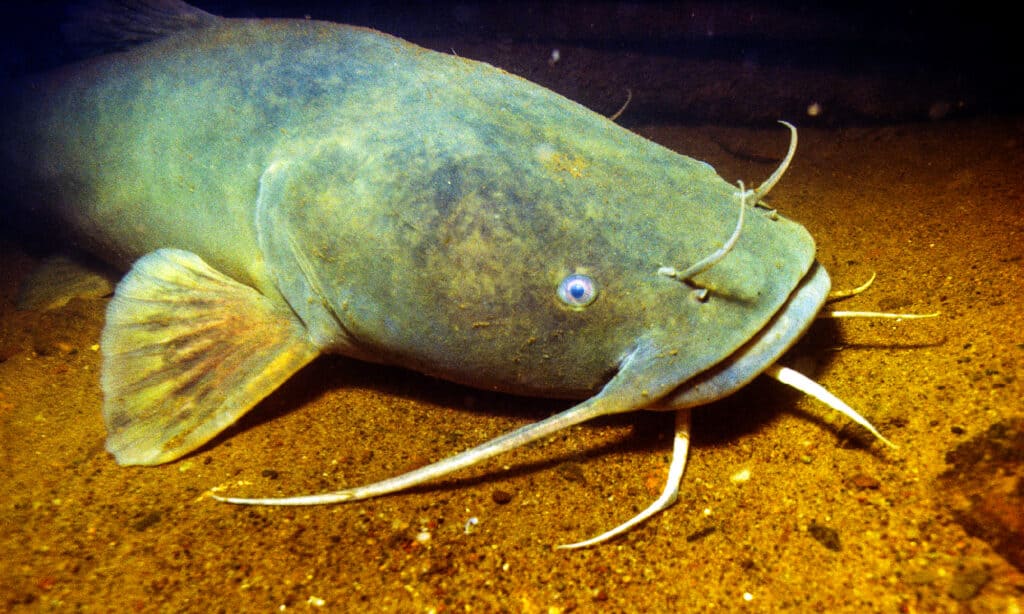A quick look at a map of Louisiana and you can understand how 17.5% of the state is covered in water. The Mississippi River makes up the eastern border and the southern border is on the coast of the Gulf of Mexico. All along the coastal marshes are small lakes as well as a few good-sized lakes like Lake Pontchartrain and Lake Borgne. On the western border is a large man-made lake, the Toledo Bend Reservoir, which is shared with neighboring Texas. Although these are some of the biggest lakes, are they also the deepest lakes? There is a fascinating story behind the deepest lake in Louisiana, it wasn’t always the deepest. Read on to discover all about the deepest lake in Louisiana.
What Is the Deepest Lake in Louisiana?
The deepest lake in Louisiana is Lake Peigneur, but it wasn’t always the deepest. Lake Peigneur was a 10-foot-deep freshwater lake until November 20, 1980. A few days later it was a 200-foot-deep saltwater lake. How is that possible?

What Happened to Lake Peigneur?
Lake Peigneur was swallowed up in a massive sinkhole caused by a drilling mistake. On November 20, 1980, an oil rig was out on the lake doing some exploratory drilling. The problem is, under the lake was a salt mine. Not an old abandoned mine but a functioning mine owned by the Diamond Crystal Salt Company and on November 20 there were 55 employees working away in the mine. Can you see where this is going? The oil rig had received detailed maps of where the salt mine was and obviously knew how important it would be to not drill into the mine, however, their calculations were off and their 14-inch drill broke through the top of a portion of the mine.
Water from the lake started to leak into the mine and then started to wash away all the soil and sediment. It was like pulling the plug in the bathtub as all the freshwater from the lake, as well as everything on the lake, was sucked into the hole.
What Happened to the Workers in the Mine under Lake Peigneur?
All 55 workers in the mine were evacuated safely. They had practiced evacuation drills and routinely maintained the elevator so they were able to get out of the mine in time. There were no deaths and no injuries due to the sinkhole. The mine, however, was completely destroyed.
What Happened to Everything Else that was on Lake Peigneur?
Everything got sucked into the sinkhole. The oil rig, drilling platform, and eleven barges all got sucked in. A man out fishing in a small motorboat rushed to shore and was able to get to safety, but his boat was not as lucky. A tug boat that tried to save the barges got sucked in after the tug boat driver was safe. As the sinkhole gained momentum it eroded the surrounding shoreline and dragged 65 acres of land, including trees, into the hole. A botanical garden, the Live Oaks Gardens which was on an island was destroyed. Only one house was affected but it was completely covered in water. To this day you can see the chimney sticking up out of the water as a reminder of the accident.
How Did Lake Peigneur Become a Saltwater Lake?
The power of the sinkhole started to pull water in from the Delcambre Canal, which usually flowed south into the Vermillion Bay that empties into the Gulf of Mexico. This was the only time in history when the water from the Gulf of Mexico flowed into the U.S.! For almost three days the water flowed into the hole where Lake Peigneur had been, filling it in with the saltwater from the Gulf. As the water rushed into the gaping hole it created a huge waterfall and that water fell to the bottom of the hole. The temporary waterfall was 150 feet. When Lake Peigneur was full again things settled down and everyone took stock of the damages. Nine of the eleven barges resurfaced but the rest was all lost.
Did the State of Louisiana Have to Pay for the Damages?
No. They did have to clean up the mess, but Texaco, which owned the oil rig operation, had to pay $45 million to the mine owner and the surrounding businesses, including funds to rebuild the botanical garden.
What Happened to All the Fish and Wildlife That Were in Lake Peigneur?
The accident destroyed everything that was in the lake and replaced the entire ecosystem with a saltwater lake. So freshwater fish that would have been there before such as perch, crappie, and smallmouth bass were replaced with saltwater or brackish fish like trout, redfish, and catfish. Think of all the other wildlife that was affected by the changing ecosystem. Animals like turtles, frogs, salamanders, and ducks that were used to a freshwater lake either died or had to relocate.

The Lake Peigneur accident replaced the entire ecosystem so freshwater fish were replaced with saltwater or brackish fish like catfish.
©iStock.com/stammphoto
How Deep Is the Deepest Lake in Louisiana Today?
The deepest lake in Louisiana is 200 feet deep. The deepest point in Lake Peigneur is 20 times deeper than it was back before 1980.
Where Is the Deepest Lake in Louisiana on a Map?
Lake Peigneur is located in the southcentral portion of the state. Lake Peigneur is close to the town of Delcambre, which is situated south of the lake, and New Iberia is to the east.
What Is the Biggest Lake in Louisiana?
Lake Pontchartrain is the biggest lake in Louisiana. It is located just north of New Orleans and is 629 square miles. While it is the biggest lake, it is nowhere close to the deepest and only averages 12-14 feet deep. Fishing on the lake is pretty decent with good-sized bass, catfish, redfish and speckled trout. There is no salt mine under Lake Pontchartrain, so it is safe from a disaster similar to the infamous Lake Peigneur.
The photo featured at the top of this post is © © OpenStreetMap contributors”, CC BY 2.5
Sources
- Louisiana Tech Digital Commons, Available here: https://digitalcommons.latech.edu/cgi/viewcontent.cgi?article=1036&context=engineering-science-magazine
- KLFY, Available here: https://www.klfy.com/local/iberia-parish/40th-anniversary-of-salt-mine-breach-creating-louisiana-deepest-lake/
- USGS, Available here: https://www.usgs.gov/special-topics/water-science-school/science/how-wet-your-state-water-area-each-state
- U.S. News, Available here: https://www.usnews.com/news/best-states/louisiana/articles/2022-01-08/podcast-turns-spotlight-on-lake-peigneur-disaster-of-1980
Thank you for reading! Have some feedback for us? Contact the AZ Animals editorial team.






